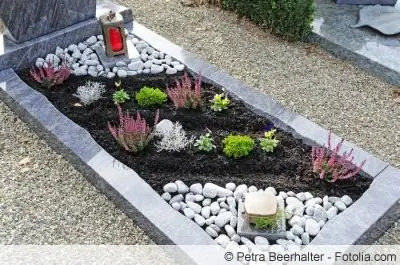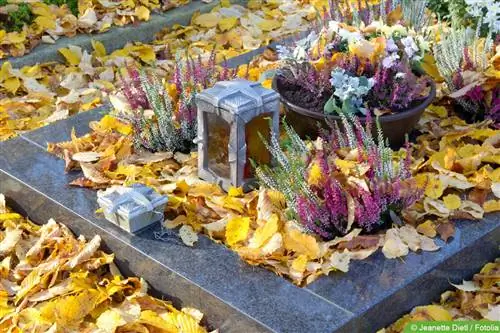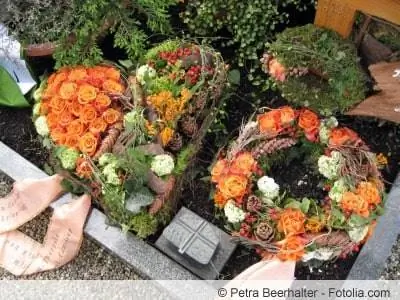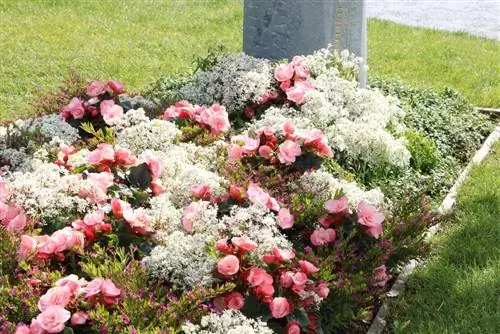- Author admin [email protected].
- Public 2023-12-17 03:39.
- Last modified 2025-01-24 12:45.
Designing the grave of a loved one so that grave maintenance is easy is not that difficult. Because many suitable perennial perennials or shrubs and a few stones make this possible. If the grave design is designed correctly, the surviving relatives do not have to invest a lot of time in care, which is usually not even available.
When a loved one is gone, the grave is lovingly cared for by those left behind. However, there is not always time left to go to the cemetery and look after flowers and plants there. But there is also a solution for easy-care grave design with stones and plants. Before planning and laying out the cemetery regulations should be read. Despite everything, there are many options for designing the grave with the desired plants and stones so that it fits into the overall appearance of the cemetery and also pleases all the surviving relatives.
Create a grave
Before you can plant and pile up gravel or stones, the bed must be prepared accordingly. If you don't want to hire the cemetery gardener for this, who usually just pours in the earth, you can also do the new work yourself. Since the earth will sink after it has been poured, it is advisable to wait up to six months before making the final grave design. During this waiting period, fresh flowers or arrangements can be placed before preparing for the final grave arrangement as follows:
- the whole bed needs to be dug about 25 cm
- remove old roots, weeds and old stones
- dig up well afterwards
- Underground sand or gravel
- spread a plant fleece on the bed
- In the places where plants are planned later, the fleece is cut in the shape of a cross
- place all plants in their final place as previously planned using the sketch created
- then pour or drape the gravel or stones around the plants
- A layer of gravel or stone slabs can also be used around the grave
- because the relatives are also responsible for the immediate surroundings of the grave site
Tip:
If a new grave is created, then all those left behind must also be pleased with it. It therefore makes sense to make a sketch before designing and to clarify together where gravel and stones should be placed, which shapes should be chosen for the backfill and which plants should be cultivated. If this does not happen, there may be subsequent disagreements among the surviving relatives and, in the worst case, the grave will have to be redesigned.
Stones and gravel
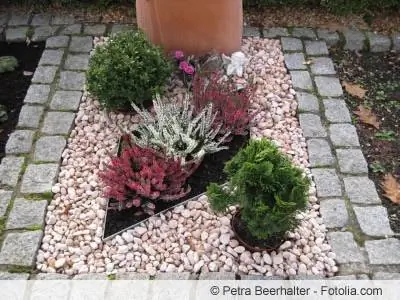
For a grave that needs to be easy to maintain, it is advisable to use beautiful natural stones as larger stones or in the form of gravel and thus occupy part of the grave area. In this way, new planting is avoided in these regions. Stones that look particularly beautiful in white or light gray can also be used as borders around the grave bed. Natural stones such as quartz, Bordeaux, bas alt or granite are suitable for grave design. Marble, especially if it is bright white, is not that suitable and is not welcome in most cemeteries. White marble in particular requires a lot of care and can quickly look unsightly due to penetrating moisture or leaves that leave their color on the marble. When choosing the color of the stones, you should pay particular attention to ensuring that they harmonize with the gravestone and the surrounding graves. When buying stones and gravel, the following must be taken into account:
- Measure the size of the area to be covered with gravel or stones
- Select stone type
- Choose grit
- The specialist retailer can use this information to calculate the required quantity
- Stone border, inlaid stone slabs and gravel should harmonize in color, but do not have to be identical
- light gray goes very well with anthracite or white and black
- subtle patterns can be formed from this
- The stone slabs serve as a base for plant bowls or grave candles
Tip:
It looks particularly appealing when different patterns are formed from the gravel or stones. Circles of larger stones can be created around the plants, gravel can be piled in circle or diamond shapes, stone formations or a stone slab can serve as a base for grave decorations.
Suitable flowering plants
Usually a grave is planted with early-flowering plants in spring and late-flowering plants in summer/early fall. To make it easier to care for, evergreen plants also look very good all year round. In between, individual flowering perennials can be planted so that one or two splashes of color can be seen throughout the year. In addition, ground cover plants look aesthetic and attractive between the stones. The easy-care grave planting could therefore be mixed from the following plants. Care should always be taken to ensure that the motto “less is more” is generally adhered to. If a grave is overloaded with flowering and evergreen plants, it quickly looks unkempt. The following plants are just examples from which every bereaved person should choose their favorite plants:
- Suitable ground cover plants include ysander, ivy but also ground cover roses and ground-hugging grasses
- For a gravel bed, spurge, sedum, stonecrop or speedwell and yarrow are particularly suitable
- this gives the bed between the stones a colorful look
- Flowering, easy-care and, above all, perennial perennials are also suitable
- these include coneflower, lavender, lady's mantle, autumn anemone to name just a few
- the perennials can be used to add color accents all year round
- cultivate early and late bloomers together
Tip:
If you want and can invest a little more time in grave care, you can also change plants depending on the season. Tulips, daffodils or pansies are ideal in spring, geraniums or daisies in summer and heather, dahlias or chrysanthemums in autumn. This alternating planting can also be placed on the grave in a bowl according to the seasons.
Evergreen bushes and shrubs
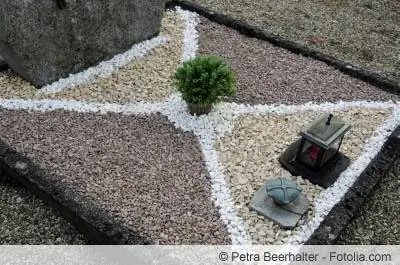
Conifers and other evergreen shrubs such as boxwood, rhododendron or similar are also often cultivated for the grave, which make a beautiful picture even in winter. In a cemetery, however, it is important for the overall picture that these are cut regularly and that the growth does not get out of hand. Therefore, these bushes and shrubs are ideally always placed at the top of the grave next to the gravestone as a finish or in the middle of a grave. However, caution should be exercised here and the bushes should be placed in such a way that the gravestone can still be easily seen and read.
Tip:
If evergreen, perennial shrubs are cultivated alongside the flowering plants, then the grave will look well-kept even in winter when most of the flowering plants have faded.
Grave decorations on memorial days
On personal or church memorial days, additional grave decorations can be placed or placed on the bed. However, this is up to each individual. This means that discreet grave decorations can be placed all year round.
In this way, changing color accents can be placed on the grave all year round. This is particularly useful if the grave was created without a lot of flowering plants and more stones, gravel and evergreen plants were used because of their ease of care. The grave decorations include:
- fresh bouquets of flowers in a vase, which can also be changed weekly
- Arrangements
- Flower bowls, which can also be left all year round and are always freshly planted
- Wreaths
Conclusion
Stones, gravel and easy-care perennials as well as evergreen bushes and shrubs are modern and have been found more frequently on graves in recent years. Nevertheless, the grave designed should be adapted to the cemetery; the surviving relatives can inquire about this at the responsible cemetery office before it is created. This way it is easy to always have a well-maintained grave without having to put in a lot of effort. To ensure that there are always flowers here in spring, summer and autumn, a bowl with flowering plants can be set up at regular intervals according to the season. This is particularly suitable for graves where there are otherwise little to no flowering plants but only evergreen shrubs and bushes. This means that neither the care nor the costs are too high for the surviving relatives.

